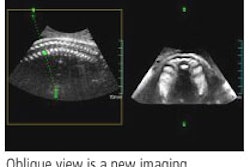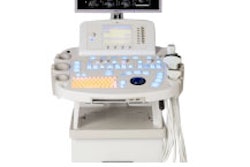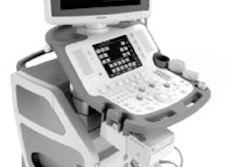CHICAGO - Contrast-enhanced hepatic ultrasound could help grade the severity of liver disease, according to research presented Wednesday at the 2005 RSNA meeting.
"Analysis of the data of the first passage of (the ultrasound contrast agent) through the hepatic vein could be useful in monitoring patients affected by chronic liver disease," said presenting author Dr. Teresa Abbattista. "There is in fact a significant difference in the analysis of the contrast arrival time between cirrhotic and noncirrhotic patients."
To evaluate whether second-generation ultrasound contrast agents could grade diffuse liver disease severity, a team of researchers from Ospedale Civile di Senigallia, in Senigallia, Italy, enrolled 43 patients in a prospective trial. The patients included 28 males and 15 females with a mean age of 55.5 years.
Fourteen of the patients had clinical and/or histological diagnosis of liver cirrhosis, 19 had histologically proven noncirrhotic diffuse liver disease, and 10 were without liver disease. Following a standard ultrasound examination, all patients received a bolus injection of SonoVue (Bracco, Milan, Italy), given intravenously followed by a saline flush.
The researchers then recorded the intensity of the Doppler trace of the middle hepatic vein from 20 seconds before to two minutes after the SonoVue injection. They defined arrival time as when the signal began to increase after the SonoVue injection, and peak time was the time of maximum signal.
For cirrhotic patients, the arrival time was 13.3 seconds (± 2.9 seconds); arrival time for patients with noncirrhotic liver disease was 21.6 seconds (± 3.6 seconds). Arrival time for patients without liver disease was 25 seconds (± 4 seconds).
The researchers also found that arrival time was lower (12.3 ± 2.7 seconds, compared with 15.2 ± 1.6 seconds) in absence of portosystemic shunts such as esophageal varices. Raw data from the cirrhotic group also showed that an arrival time of less than or equal to 17 seconds was a cutoff, distinguishing patients with liver cirrhosis from noncirrhotic ones, according to the researchers.
Using that measure, sensitivity was 100% with specificity of 93%. Diagnostic accuracy was 95%, while positive predictive value was 88%.
The researchers didn't observe any side effects from the SonoVue injection, and found no statistically different differences in peak time among the three groups.
By Erik L. Ridley
AuntMinnie.com staff writer
December 1, 2005
Related Reading
CEUS shows metastases' hypervascularity, November 27, 2005
Ultrasound contrast enhances liver imaging, May 11, 2005
Contrast US pinpoints focal liver lesions, results in cost-savings, March 25, 2005
Breath-hold technique comparable to respiratory-triggered MR for liver imaging, March 16, 2005
Exam technique critical in liver ultrasound, October 22, 2004
Copyright © 2005 AuntMinnie.com



















